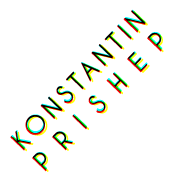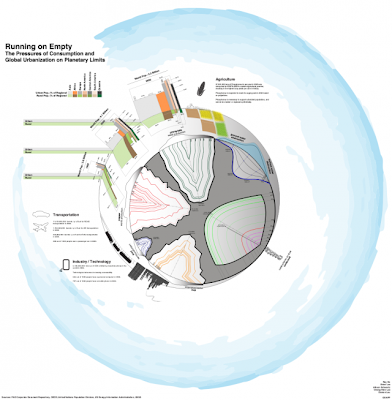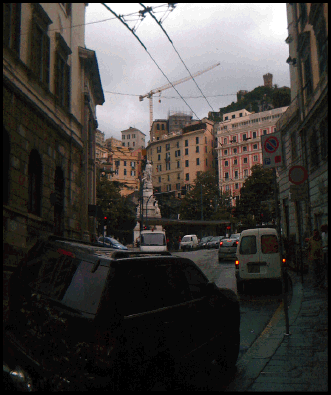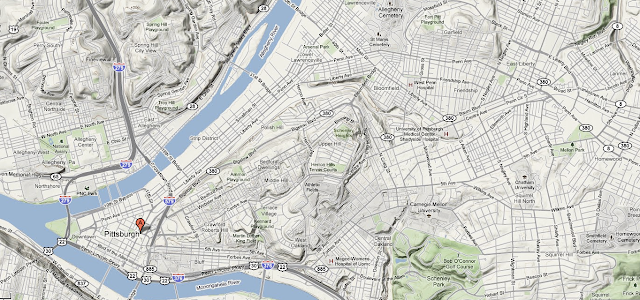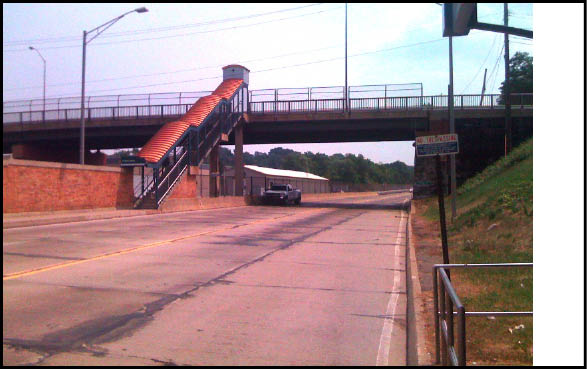We plotted our route to get there, the bike ride would take 48 minutes but in the midday heat we decided to take the bus, which would be about one hour. The directions told us to take three buses, the base fair was $2 plus 75 cents for every transfer.

We took our bikes and took one main bus. Biking to the bus station:
In Pittsburgh there is a valley where train trax where laid because it was the flattest part. Here at some point they also built a road parallel to the tracks called the Bus expressway, this is a road closed to all traffic with no off/on ramps that is only used by a line of buses and service/emergency vehicles. To get to the bus station we had to cross a long bridge with a narrow walkway and two lane roads, then go down below to where the trax and bus station were.

The whole thing resembled what would be a train line but with a big road and busses that come at least five minutes late. Quite surreal experience, something like a deserted highway. The buses come every 15 minutes, otherwise the place is empty. Not all busses stopped at this station.
As we got off in Swissvale, the end of the line, the bus station was situated in the middle of a parking lot, one had to cross all the rows of cars to get out. The bus was a long double sized kind that bent in the middle.
It had two bike racks in the front, Swissvale was about a mile or so from Braddock, but really nothing was in walking distance. We biked to what became a highway like road spilling out from an old single lane bridge to a 10 foot wide lane road with off ramps and no buildings or services on the side on the sides. The road had a small pedestrian walk way but no shoulder on the lanes.
Because of construction we had it easy and where able to wave between the cars to switch to the left lane and exit into Braddock. There are two ways to get to Braddock, this is one of them. Seems like without a car this would be a uncomfortable and dangerous path to take. More on options to follow.
 Coming into Braddock from the bridge I was not sure what to expect, some called it Brooklyn 2.0, others still a broken town. A gust of rain came down as we rode into the center of town. Grandiose stone buildings, with ornate coulombs juxtaposed with the usual array of early 20th century utilitarian brick buildings with many empty lots in between them that lined the margins. We walked into a shop thinking it was a grocery store, it was a butcher/sea food place, there was no grocery store in town. The areas touched by the new initiatives were obvious. There was a empty lot in the central area from where a big building used to stand that was turned into a park with lots of teenagers doing something having to do with an organization. I had a map of some of the art work done in Braddock by artists in the area, we looked around the neighborhood for a sense of the place.
Coming into Braddock from the bridge I was not sure what to expect, some called it Brooklyn 2.0, others still a broken town. A gust of rain came down as we rode into the center of town. Grandiose stone buildings, with ornate coulombs juxtaposed with the usual array of early 20th century utilitarian brick buildings with many empty lots in between them that lined the margins. We walked into a shop thinking it was a grocery store, it was a butcher/sea food place, there was no grocery store in town. The areas touched by the new initiatives were obvious. There was a empty lot in the central area from where a big building used to stand that was turned into a park with lots of teenagers doing something having to do with an organization. I had a map of some of the art work done in Braddock by artists in the area, we looked around the neighborhood for a sense of the place.
 The geography of Braddock went something like this. S.Braddock was in the valley, flat with the train tracks and the main business. Running directly east from the Pittsburgh side was S.Braddock ave was the main strip, going along this as the street numbers went up one would eventually arrive at the Mill and some other heavy industry looming over the horizon when in the valley. North Braddock was up the hill, the more residential part of town, with a mix between larger Victorian buildings and small one story wooden houses. This is where the Transformazium and the adobe dome project were going on. In general the streets off the main strip had a varying amount of either empty lots or a mix of brick and wooden small, working class houses mostly abandoned and overgrown. The buildings resembled that somewhat suburban look found on the edges of towns. Above a piece by Swoon found on the side of a building. There was interspersed industrial buildings right up against residential ones.
The geography of Braddock went something like this. S.Braddock was in the valley, flat with the train tracks and the main business. Running directly east from the Pittsburgh side was S.Braddock ave was the main strip, going along this as the street numbers went up one would eventually arrive at the Mill and some other heavy industry looming over the horizon when in the valley. North Braddock was up the hill, the more residential part of town, with a mix between larger Victorian buildings and small one story wooden houses. This is where the Transformazium and the adobe dome project were going on. In general the streets off the main strip had a varying amount of either empty lots or a mix of brick and wooden small, working class houses mostly abandoned and overgrown. The buildings resembled that somewhat suburban look found on the edges of towns. Above a piece by Swoon found on the side of a building. There was interspersed industrial buildings right up against residential ones.
 We saw a flyer around town for a farmers market that happened downtown with food grown directly in Braddock a couple of blocks away.
We saw a flyer around town for a farmers market that happened downtown with food grown directly in Braddock a couple of blocks away.
Back up to S.Braddock ave at ninth st was a small garden and another mural, a block away towards the mill was the main garden.
As we came closer to the mill the smell became worse, the mix of damp humidity and gasses combined with the incessant humming noise produced a psychologically challenging atmosphere. The plant was an enormous tin structure out of scale with anything human.
 The main garden, was placed in what I though of as a unsuitable location. It was about a block away from the steel mill, in an area with a noticeable amount of air pollution from the smell and the brownish residue on the hood of the car that appeared to still be in use.
The main garden, was placed in what I though of as a unsuitable location. It was about a block away from the steel mill, in an area with a noticeable amount of air pollution from the smell and the brownish residue on the hood of the car that appeared to still be in use.
There we encountered two (vegan, straight edge) guys from Brooklyn (Bushwick) who had recently bought a house, directly facing the mill. They did not seem to mind the smell although they would smell sulfur sometimes.
 They brought their house for seven thousand dollars, the inside was a 60’s rehab looking a bit shabby but kept up and livable. The other house bought by one of the people who lived there was for one thousand dollars, that one needed a lot of work, she added.
They brought their house for seven thousand dollars, the inside was a 60’s rehab looking a bit shabby but kept up and livable. The other house bought by one of the people who lived there was for one thousand dollars, that one needed a lot of work, she added.
The buildings below was owned by the mayor and they said it was used as a sort of Hostel for artists and folks wanting to come and stay in Braddock. We were told the low down on all the other residents who recently moved here and bought property. One was a furniture maker who bought a former car dealership, decked out the place and put a greenhouse on the roof. There was also a non profit that the Mayor helped start with the aim of reutilizing vacant property. There was Unsmoke studios, an art gallery/practice space.
Going to North Braddock, up the big hill, the main street going up to the residential area had a church under construction with a playing area, basketball field, and a library. Up near where the Transformazium there was an odd thing, a new house, small, appearing to be straight out of the suburbs, around the corner of the Transformazium church there was another strip of these houses, with a car garage and all in the process of construction. (yet most of this towns older buildings stand abandoned)
 At the Transformazium no body was around, the places looked quite out of context, but had a certain kind of shine and grit kind of feel to it. A church stood on the corner and across it was an accompanying lot with the natural building structure partially completed. Several information plaques were attached to the fence stating the intentions and ideas of the project as well as taking inspiration from a similar building project in Haiti.
At the Transformazium no body was around, the places looked quite out of context, but had a certain kind of shine and grit kind of feel to it. A church stood on the corner and across it was an accompanying lot with the natural building structure partially completed. Several information plaques were attached to the fence stating the intentions and ideas of the project as well as taking inspiration from a similar building project in Haiti.
Below is the dome structure and Church/transformzim, as well as the surrounding setting. The project is particularly fitting in light of the cookie cutter suburban style development adjoining the lot.

There was a convenience store,a record store and a child care center on one side of the street a bit down the hill from the cite.
We ate lunch on the brown slabs of stones at the front yard of a large vacant brick Victorian building, on the opposite side was one similar but was recently purchased by some of the artists that work on the Transformazium.


Back down the hill in the center of town I came upon an organization called with the slogan: Empowering people, transforming lives. Called Heritage Community Initiatives. I peaked in and walked in the first set of doors. The others were locked, and I had to be buzzed in to enter the second set. When I called the buzzer the woman who answered asked who I was and what I wanted, she was a bit unfriendly. I had to front some sort of institutional credentials in order to be given the time of day. The place was an office building, tidy, and with a reception desk, with the rest of the facility hidden behind a wall. This reflected the feeling I got from the organization, I asked the woman some questions, she did not live there, I asked her personal opinion and she gave me the party line. Told me that I should schedule a meeting. I took a folder with some color papers and left.
Had a conversation with two women who ran a antique/estate sale store, and asked them about the recent advertisement that Levi’s Jeans shot in Braddock. They said their impression was positive, from their standpoint, it was good for the town. During the shoot, Levi’s bought several things from their shop as props, after they were done shooting they return the items without asking for money in return. They said they were happy to be in Braddock but their building was in need for some serious repair, the roof has been leaking for some time now.
At that point the day was done and so we headed back on our way to Pittsburgh.
Reflections:
The interesting thing about Braddock is twofold. One it is a shrinking city that is not afraid to take risks, two is that it’s far enough away from Pittsburgh that the issue of gentrification does not carry the same context.
It’s not afraid to take risks in that, at least on the part of the Mayor, there are efforts in effect that are alternative strategies for use of space and of how to meet the needs of the community.
Gentrification usually has some sort of capital base that attracts people enough to move to the area, and a preexisting overall density. Pittsburgh has it’s hospital complexes and the Carnage University , besides the mill, there is nothing of the sort in Braddock. In short it’s a small town ten miles away from Pittsburgh proper, so in the eyes of the developers and geographically, there are more favorable places to gentrify. Braddock resembles more of a ghost town and less of the typified urban ghetto.
The scale is also quite different. Often in rustbelt cities it is the stagnant bureaucracy that inhibits activists and people with visions to be able to create a change they want in the city. In the larger cities cause and effect are more distant from each other. The politicians and policy makers never even have to interface with the general population or have a pulse of what sort of problems are occurring on the ground. In a smaller city there are less variables, less stakeholders and ultimately less formalized ways of doing things that makes taking action more accessible.
At the moment, Braddock seems to be at a tipping point. Or that it’s oscillating between two points. One is that artists, activists and social entrepreneurs that settled there will place their roots deeper in the community and settle for an extended period of time. Others inspired by the events at Braddock will move there as well with their own idea or to participate in a project, this will thicken the group of people focused on social/infrastructural change and bring about larger projects in the alternative ways of living and doing things.
Another out come is this: Those people who moved here from culturally rich urban areas, have gotten used to a certain degree of intellectual stimulation of being exposed to new and variating things common in big cities. They will feel the on sent of boredom or isolation, and as a result will feel hesitant to trust that this place can develop into a supportive community that can meet those need for them. They will vacate their houses and move back to New York or where ever. Due to this there will be a lack of a base of people putting active pressure to transform Braddock and those present will feel daunted by the immense amount of work needed aside from rehabbing their own houses. In that sense Braddock will reach a plateau where certain initiatives will continue but will not culminate to any kind of substantive radical restructuring of it’s present condition.
Despite all the odds, Braddock has got the hard part down, as the old saying goes:
“The secret is to really begin.”
